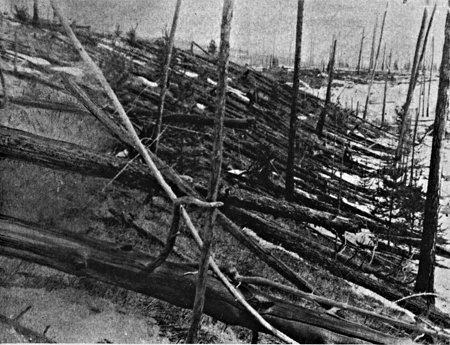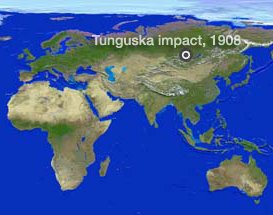On June 30, 1908, an object from space hit a remote forest in Tunguska, Siberia, causing an explosion equivalent to 185 Hiroshima bombs.

This year, 1908, a little after seven in the morning local time. A man sits on the front porch of a commercial complex in Vanavara, Siberia. A few minutes later he will be thrown from the chair and the heat will be so strong that he will feel as if his shirt is on fire. This is how the Tungaska event was felt more than 60 kilometers from its center point.
This week, on June 30, 2008, the scientific community marked the XNUMXth anniversary of the brutal hit from the sky near the Podkamenya Tunguska River in Siberia. A hundred years after the event it is still a topic of conversation among scientists. "If you want to start a conversation with someone in the asteroid business, all you have to say is 'Tonguska,'" says Don Yeomans, Near-Earth Object Project Manager at NASA's Jet Propulsion Laboratory. "This is the only entrance of a large meteorite that we know of in the modern period, and that we can observe its consequences first hand."
Although the event took place in 1908, the scientific expedition to the area waited 19 years. In 1921, the chief curator of the meteorite collection at the museum in St. Petersburg led the expedition to Tunguska, but difficult conditions in the Siberian steppe prevented the team's attempt to reach the explosion area itself. In 1927, a new expedition, led by Kulik, managed to achieve the goal.
"At first the locals were hesitant to tell Kolik about the incident." Yeomans tells the NASA website. "They believe that the explosion was a punishment from heaven by the god Ogadi, who cursed the area by flattening the trees and killing the animals." But while it was difficult to obtain evidence from humans who were present nearby, the physical evidence was 800 square miles (about 2,000 km80) of remote forests torn apart. XNUMX million trees leaned on their sides and rested in a circular pattern. "These trees marked as markers and pointed precisely out from the center of the explosion," Yeomans said. "Later, when the team reached ground zero, they found that the trees there were standing upright, but their branches and bark had been torn from them. They looked like a forest of telephone poles.”
Such a result requires a fast moving shock wave that broke the tree branches before the branches could transfer the impact momentum to the trunk. 37 years after the explosion in Tunguska, trees without branches could also be found next to the center of another massive explosion - in Hiroshima, Japan.
Kulik's expeditions (he went to Tunguska on three separate occasions) were finally succeeded by one of the locals who agreed to talk. It was the man who was sitting on the balcony in the commercial area in Vanara, and who witnessed a wave of hot air that lifted him from the chair. And here are his words. "Suddenly in the northern sky... the sky split into two, and high above the forest, the entire northern part of the sky seemed to be covered in fire.. At that moment, there was all the noise from the sky and a huge crash... After the crash I heard a noise that sounded like stones falling from the sky, or like gunshots. The earth shook."
The explosion was extremely compressed. The result, seismic shock waves were recorded in sensitive barometers in far away England. Compressed clouds formed above the area at high altitude and reflected the sunlight beyond the horizon. The night sky was clear, and citizens from remote parts of Asia could read newspapers outside the house at midnight. Closer to the scene, hundreds of reindeer, the livelihood of the local shepherds, were killed, but there is no direct evidence that humans were killed in the explosion.

"A hundred years later there are still different scenarios as to the possible cause of the explosion," Yeomans said. "But the general consensus is that on the morning of June 30, 1908, a large rock, about 30 meters in diameter, entered the atmosphere over Siberia and exploded in the air." It is estimated that the meteorite arrived at a speed of about 54 thousand km/h. During the rapid dive, the rock weighing about one hundred thousand tons heated the air to a temperature of about 25 thousand degrees Celsius. At 7:17 am local time, at an altitude of about 8.5 km. The combination of pressure and heat caused the asteroid to disintegrate and vaporize, creating a fireball that released energy equal to that of 185 Hiroshima bombs.
"This is why there is no impact crater" says Yeomans. "The vast majority of the material in the asteroid was consumed during the explosion." Yeomans and his colleagues in the Near-Earth Object Project at JPL, were asked to track the paths of comets and asteroids that cross the Earth's orbit and could pose a potential danger to our planet. Yeomans estimates that, on average, an asteroid of the type that hit Tunguska enters Earth's atmosphere about once every 300 years. "From a scientific point of view, I think about Tunguska all the time" he admits. However, if we put the issue into perspective, "the thought of another event of this type in the near future does not keep me up at night."

18 תגובות
In addition, you are right Arya Seter and Halley's comet had a stormy reception. Maybe we deviate a little from the article, but, if anything, accept the reception for Halley's Comet in 1910 in Jerusalem. An experience to read.
http://www.e-mago.co.il/Editor/history-1458.htm
good week
Sabdarmish Yehuda
to Arya Seter
Nevertheless, if a number of cycles before that he shed the Tungaska factor then what is it for him to be earlier or later by a number of years.
But this is just a wild guess and the possibilities are many.
You can't deny that this is a beautiful conspiracy, no less than an alien ship!
good week
Sabdarmish Yehuda
Lesbadramish
Halley's comet was with us in 1910 and I guess two years before that it was not close enough to throw a piece of it at us. By the way, in 1910 he had an unusual performance, in contrast to the disappointing performance in 1986.
With what confidence do scientists and others decide what really happened in a place and event that has never been fully investigated.
It was not mentioned in the article that unusual radiation was measured on the spot, and the explanation once given, of radiation arising from an unusual element that was in the meteorite, is forced.
It is a shame that more serious efforts are not invested in this most unusual event.
As far as I remember, this year a new research expedition was supposed to go there. Has anyone heard details about this?
Hanan Sabat
http://WWW.EURA.ORG.IL
Fascinating, thanks.
To Roy:
The argument about a "natural hydrogen bomb" was raised in one of the studies. Since radioactive remains and mutations in the vegetation were found at the site, this was the basis of the claim, in addition to the enormous destruction and high humidity that was caused. This argument (as far as I remember) claimed that it was a failed experiment (some even linked Nikola Tesla to the matter) or the crash of an alien ship whose nuclear engines exploded. The astronomers D'Alessio and Hermes proposed in 89 a theory that a comet that contained an extremely high percentage of deuterium underwent nuclear fusion and exploded like a natural hydrogen bomb. Another researcher, Cesar Sirvant, made a similar argument in 1990. According to him, an initial explosion (from some source - and he does not go into details), released kinetic energy, which started a thermonuclear explosion process.
Of course, I am not here to deny or verify these theories, but only to claim that they have been presented and that in any case they cannot be easily refuted or verified with certainty.
Hanan Sabat
http://WWW.EURA.ORG.IL
Hanan,
Is there evidence for arguments like 'natural hydrogen bomb'? Something supported by the evidence on the ground? Or an explanation of how such a bomb is formed in nature at all?
Thanks,
Roy.
I will be allowed to disagree on one fact - on the argument that there is consensus that it was a rock. This is Yeomans' private opinion and it is not the agreed opinion as far as I know the event.
In my opinion, it is more correct to say that there are several arguments: an asteroid, a meteorite, a small black hole, antimatter, a natural hydrogen bomb, an electromagnetic storm, a comet, and there is even talk of an extraterrestrial spacecraft.
In recent years, the opinion that it was an asteroid is emerging, but even in this case, there is still no proof, only an assumption. The findings that were discovered are problematic, since this is definitely a different event from the ones we are familiar with in meteorite impacts.
Hanan Sabat
http://WWW.EURA.ORG.IL
It is difficult for me to accept the absolute certainty of the data in the article, such as 185 Hiroshima bombs and 54000 km/h, and a diameter of about 30 meters and a weight of about 100,000 tons, and all this from conclusions made based on data received decades after the event.
If the diameter and mass data are like this, then it is a body whose density is 7, meaning that most of it is made of iron. Most likely such a body would reach the ground and form a crater.
The approach that claims that the body was mainly a block of ice, snow and gravel, i.e. a fragment of a comet, is more acceptable to me and would more logically explain its explosion high in the atmosphere and the fact that no typical impact crater was formed.
On the 99th anniversary of the event (a year ago), an article on the subject was published here, on the Hedaan website, and there the data were logically, less decisive.
I would like to refer readers to various data in other articles on the same topic, for example:-
http://www2.kinneret.ac.il/bloss/apod/default.asp?date=14/11/2007
What is more frightening, is the frequency of hitting such bodies. Almost certainly, every few hundred years. And if we take into account smaller entities that can only destroy a few tens of square kilometers (a medium-sized city), then this is about a frequency of every few decades.
It remains for me to try to guess who is the comet that contributed the "Tonguska factor",
So, … how about Halley's Comet being near Earth at that time?
And by the way, it is made of 80% water, in addition to frozen gases and only a very small amount of iron.
Food for thought.
Have a quiet weekend
Sabdarmish Yehuda
I don't want to think what would have happened if it had been in a place with a high population density